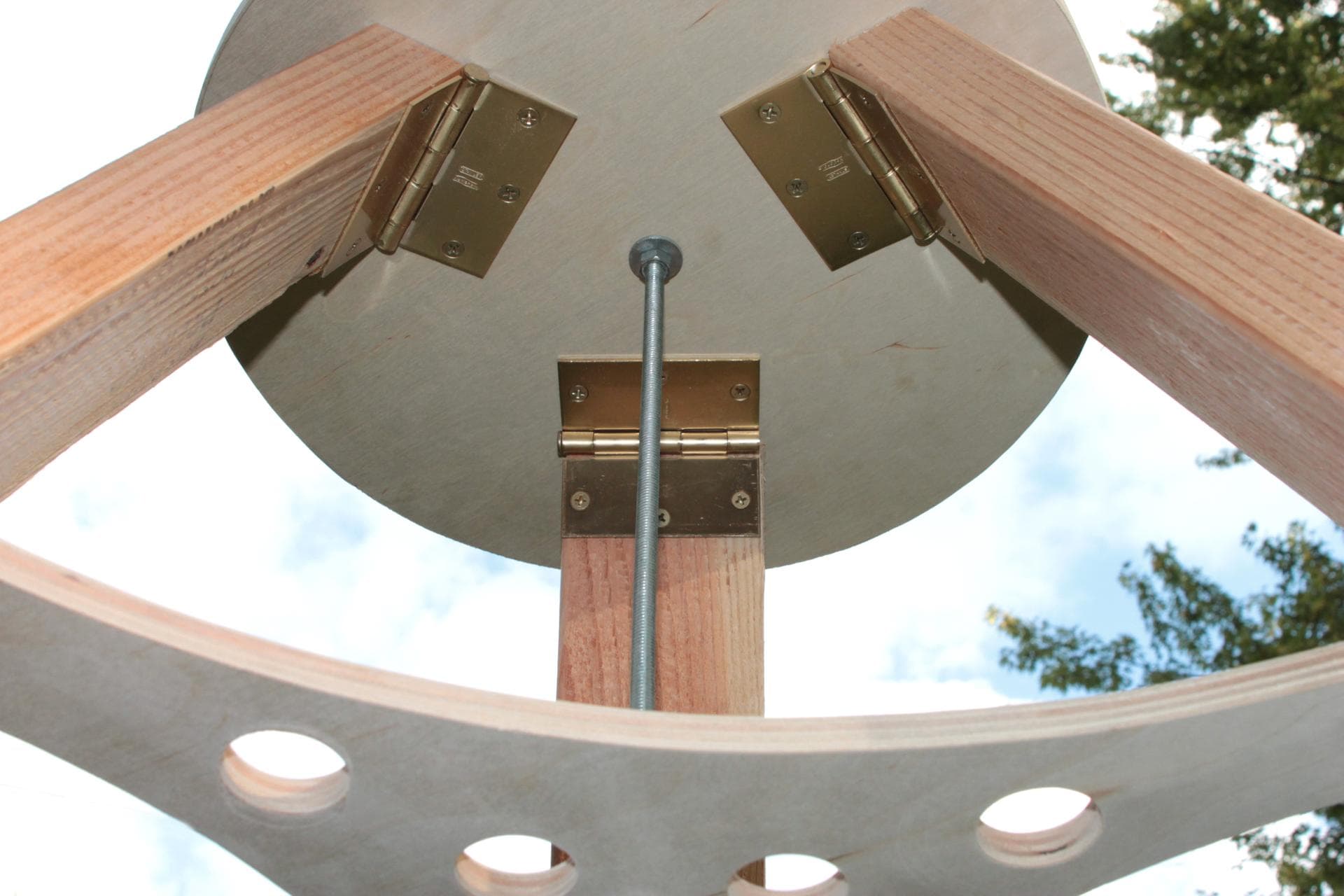Free plans for how to build a simple, easy-to-build tripod from 2x4's, plywood and some basic hardware (with instructions and pictures)
* This tripod was featured in the February 2013 issue of Sky and Telescope *
The Super Simple Tripod 2x4 is a very strong, easy to build, low-cost tripod with a large upper surface that can be used for a variety of purposes. It's intent here is to use it for tabletop telescopes like the Orion Funscope, Orion SkyScanner, Edmund Astroscan, Orion Stablast 4.5, Bushnell Ares 5, and other telescopes that need a stable, table-like surface to place the eyepiece at a helpful height above the ground. This tripod is easy to make with simple hand tools by almost anyone, and is so sturdy, it is strong enough to support all of my weight (and I weigh about 175 pounds).
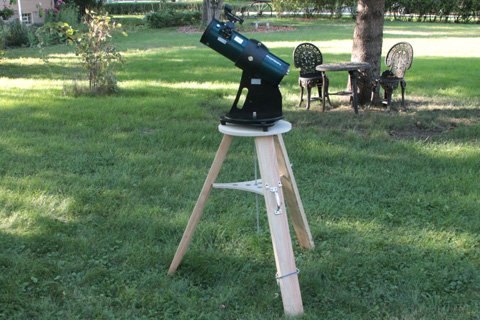
Materials:
- 2 - 2" x 4" x 8' boards (look for straight, dense, low-knot pieces of wood)
- 1 - 24" x 24" piece of 20mm or thicker plywood (for tripod heads larger than 15" across, more wood will be required)
- 3 - 3.25" door hinges (with wood screws)
- 1 - 18" length of 5/16-18 threaded rod
- 3 - 5/16-18 nuts
- 1 - 5/16-18 wingnut
- 4 - 5/16" washers
- 150 grit sandpaper
OPTIONAL:
- 1 - 5/16-18 Tee-nut
- Paint or stain/finish
Tools required
- Straight saw (or chop saw / table saw)
- Coping saw (or jigsaw / sabre saw)
- Drill and drill bits up to 5/16"
- Phillips head screwdriver
- Wrench (crescent wrench or even pliers will do
PDF files
- SST2x4 tripod head with hinge/leg locations
- SST2x4 spreader bar bracket shape
- SST2x4 leg length and angle template
The Super Simple Tripod 2x4 is built very similar to the Super Simple Tripod 1x3 (see instructions here), but with a few differences. One, the legs are obviously larger and stronger, being made from 2x4's. But the top is intended to be larger, and able to hold quite a bit of weight. Also, although the hinges can be placed closer together to make a smaller head for the tripod (much like the SST1x3), the idea is that you can create a tripod that has a fairly large surface area to hold tabletop telescopes, and able to both transport the tripod easily - and, for those of us with lots of trees in our yards - pick up the tripod and telescope quickly and easily to view another part of the sky.
The Super Simple Tripod 2x4 does just that.
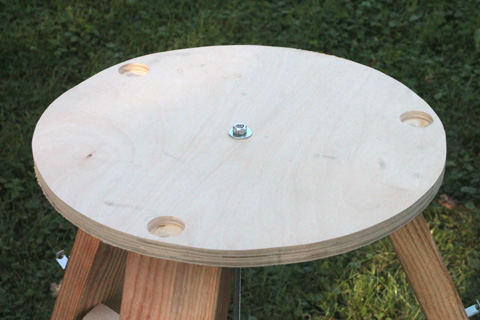
I designed this tripod to hold an Orion Starblast 4.5 (see top picture), so the head is 15 inches (38 cm) in diameter.Without modifying the templates below, it can be made to have a head as small as 12 inches in diameter, and as large as 18" with little modification. That offers a pretty good range for most tabletop scopes out there. With short enough legs and a large enough head, it could even work well to boost the eyepiece height of 4.5" and 6" Dobsonian telescopes to more comfortable observing positions.
Let's begin with wood selection. When buying wood for this project, don't skimp too much. This is a low-cost tripod as it is and 2x4's aren't very expensive anyway, so search for strong, dense, straight pieces of wood. When looking at plywood, search for the better material, not the 5 or 7 ply stuff. You only need a 2 foot by 2 foot piece, so look for some birch laminated plywood. This tripod can last a very long time - and may outlast some telescopes - so get something decent - it need not be Baltic Birch, but an 11 ply birch laminate will look nice and last a long time if properly finished and cared for.
Start by cutting the legs. Make a 22.5 degree cut on each end of the 2x4's (you only need three), then cut them to the appropriate length for your needs. Download the template above if you do not have a chopsaw or other appropriate power tool to cut the legs at an angle. I chose a 38" length (length of the board on one side), as this placed the top of my tripod close to 36" high. See table below for leg lengths / tripod heights (assumes 1" thick wood on tripod head):
| 42" legs | 39" tripod height |
| 38" legs | 35.5" tripod height |
| 34" legs | 32" tripod height |
| 30" legs | 28" tripod height |
| 26" legs | 25" tripod height |
Next cut out the circle for the tripod head. Again, a rather large range can be used, but 12 to 15 inches will be the most stable (30 cm to 38 cm). Be sure to mark and drill out the center hole for a 5/16" hole. Download the tripod head template above to both draw the appropriate sized circle, and mark the center hole and hinge/leg locations. Then, using an appropriate saw for curved lines, cut out the tripod spreader bar brace. Again, cut out the center hole with a 5/16" (or similarly sized) drill bit.
Then, trace the locations for the hinges onto the bottom surface of the tripod head. When these are done, place the hinges in the appropriate locations and mark the hole locations for the hinge screws. Drill pilot holes for all screw locations, then attach all of the hinges.
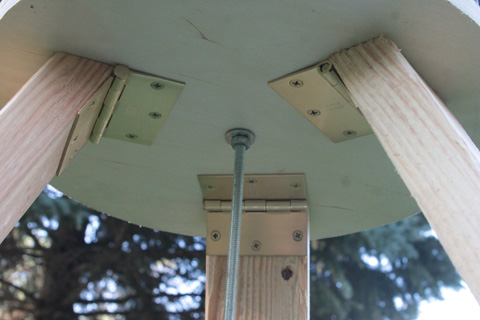
Oh yes, and while you've got the drill out, go ahead and drill a 1/4" hole in the center of the tripod head, as this is where you'll insert the 5/16-18 threaded rod as shown in the picture above.
The brace
This is really the heart and soul of this tripod. Without it, the legs just sort of flop around. The tripod is easier to kick over if the brace isn't included. It can fall much more easily.
But WITH the brace, it becomes a whole different structure. The legs become rigid. It even feels strong, despite being not all that heavy overall. And it is a very simple concept: The brace simply turns into place, pushing out on the legs, and engaging them so that the angle portion of the legs push up against the circle at the top.
Download the brace template, above. Then cut it out with scissors, and trace the shape onto the larger section of plywood left over from earlier. Be sure to mark the center hole, as that will need to be drilled out later. Using a coping saw (if hand-sawing) or a jigsaw / sabre saw if using power tools, carefully cut out the brace. Sand the edges with 150 grit sandpaper. Then drill the 1/4" hole in the center. (You can optionally draw / cut out 1.25" holes into the brace to hold eyepieces or barlow lenses if you wish, but this will require either a hole saw or a 1.25" Forstner bit.) Sand the edges with 150 grit sandpaper. I had some 7 ply 12mm plywood, so I used that for my brace:
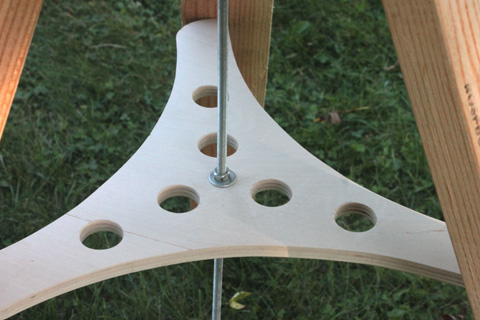
Next it is a matter of putting everything together. Place the circle on the ground, with screw holes facing up. Attach all three hinges if you haven't already. Then lean one of the legs up next to a wall or other object, with the acute angle of the cut legs in towards the hinge. Make sure the angle of the legs is exactly right on - you may need to move the circle a bit so that legs fit and set next to the hinges exactly. This is how the legs will be fitting next to the tripod head when it is set up, so be sure that this is how you place the legs when attaching the hinges to them:
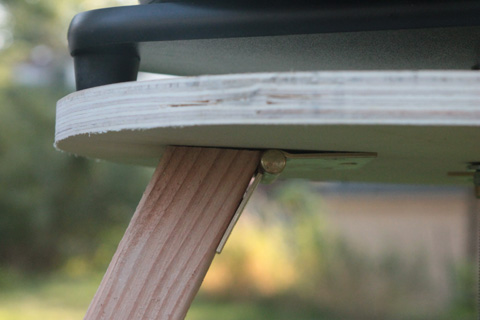
Mark each set of legs for hole placement, then drill pilot holes for each. Attach each leg, then turn the tripod over so it is upright, spreading the legs apart to their furthest reach.
Place a 5/16" nut then a washer onto the threaded rod, and rotate the nut down about an inch. Insert the rod up through the hole in the center of the circle at the top of the tripod, then place a washer and thread another nut on top of that. Tighten these in place. OPTIONAL: Drill out a slightly larger hole and use a 5/16-18 tee nut, with the "tee" on top of the circle, and thread the rod up into the tee nut, then tighten the nut underneath. This allows for a flatter "top" surface, especially if the tee nut is countersunk slightly using a router or Forstner bit.
Next, thread another nut with a washer underneath it up about halfway up the rod, from the bottom. Slide the brace up over the threaded rod, then place another washer and then the 1/4-20 wingnut up underneath it. Push the brace so that it presses against all three legs simultaneously, near the middle of each one. Thread the wingnut up until it holds the brace in place, and keeps the legs pushed outwards. Then lower the other 5/16-18 nut down onto that. You can adjust the tension on the brace or lock it in place by applying more force to the wingnut if needed. It should look like this:
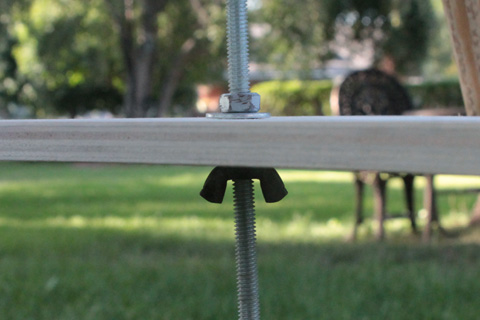
And the brace itself should be engaging the legs like this. To collapse the tripod, simply spin the brace past the legs, and they will fold up. To set the tripod back up, fold the legs out, and spin the brace so that it pushes out on all the legs again. Simple!
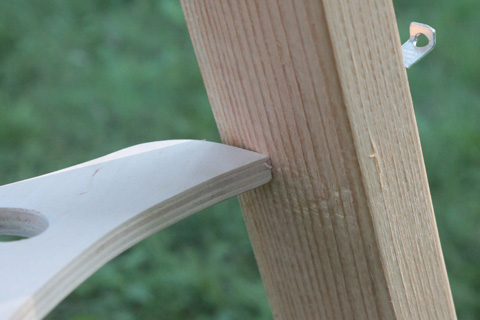
A fully functional, more sturdy, less vibration-prone astronomy tripod for tabletop telescopes! I added a few things to this, but the basic tripod as described above cost about $40 if all the wood and hardware is bought new. I had some of this wood laying around (the 2x4's, a few hinges), so your cost may be less also, but the key is this: This creates an ideal surface not only for table top telescopes, but for tablets, laptops, eyepieces, and other astronomy type equipment, even if you don't use it for a scope. It's light, easy to move, and incredibly strong.
For some additional ideas and pictures on ways to make this tripod more functional for other additions, or how to get rid of your groundboard altogether and simply keep the scope attached to the tripod, click here for the Super Simple Tripod 2x4 upgrades page.
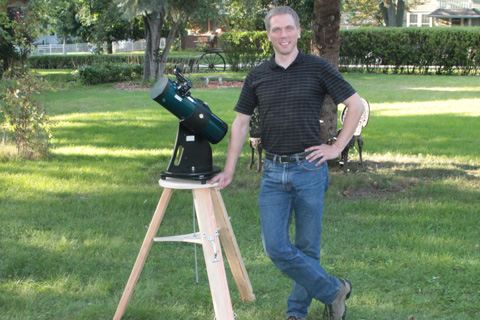
Worried about the bolt on the bottom of your scope hitting the nut/threaded rod on the top of the tripod? It's okay - the Astroblast 4.5, Funscope and Celestron Firstscope have plenty of clearance underneath them, without even having to countersink the center nut/rod. The Edmund Astroscan's center locking bolt for it's base is low enough to hit a non-countersunk bolt, but this is easily overcome by shifting the base about half an inch off center. It's really not an issue at all. Below is a picture of the Astroblast 4.5, and the clearance it has, even with the feet countersunk into the tripod head by about 3/16".

